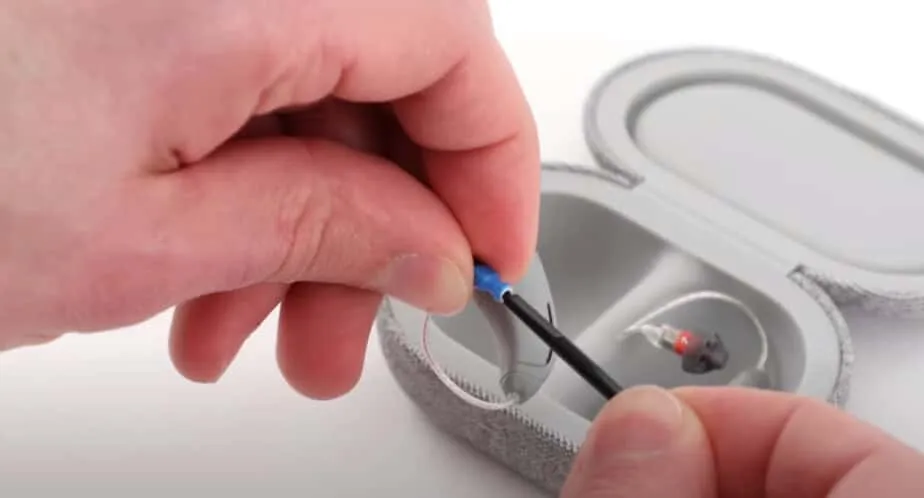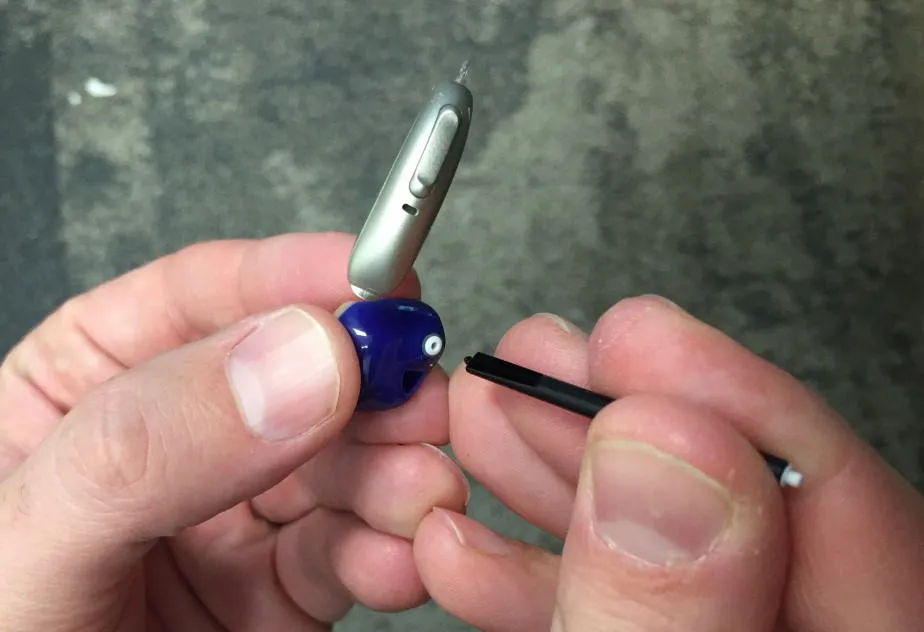By Jonathan Javid, Au.D.
Hearing aids are life-changing devices, but they operate in one of the most challenging environments possible—the human ear. Alongside sound, the ear canal produces earwax (cerumen), which protects the ear by trapping dust, moisturizing the skin, and fighting bacteria.
Unfortunately, while earwax is good for your ears, it’s not good for your hearing aids. Wax buildup is one of the leading causes of hearing aid breakdowns, and research suggests that 60–80% of repairs are linked to wax or moisture damage.
As an audiologist, I often meet patients who bring in “broken” hearing aids, only to find the issue is a clogged wax trap that can be fixed in under a minute.
What Is a Hearing Aid Wax Trap?
A wax trap (also called a wax guard or wax filter) is a tiny but essential part of many hearing aids. Its job is to act as a barrier between your ear canal and the delicate electronics inside your device—especially the receiver.
By blocking wax and debris, wax traps:
- Keep sound quality clear and consistent
- Protect the receiver from costly damage
- Reduce the frequency of hearing aid repairs
- Extend the overall lifespan of your devices
When a wax trap becomes clogged, you might notice:
- Muffled or weak sound
- Distorted or intermittent sound
- A “dead” hearing aid that actually works fine once the trap is replaced
👉 Pro Tip: Always keep extra wax traps with you. You can buy multi-packs affordably on Amazon.
Do All Hearing Aids Use the Same Wax Trap?
The short answer is no. Wax traps are not universal, and each manufacturer typically designs its own system. That means you need the correct filter for your specific brand and model of hearing aid.
Here are some of the most common types:
| Hearing Aid Brand | Wax Trap System | Notes |
|---|---|---|
| Phonak | CeruStop, CeruShield | CeruShield uses a disc-style system, easy to swap |
| Oticon | ProWax, NoWax | Widely used, easy stick-based system |
| Starkey | Hear Clear | Disposable guards replaced with tool stick |
| Widex | CeruStop | Cross-compatible with Resound, Unitron |
| Resound | CeruStop | Universal with Widex, Unitron, some Phonak |
| Unitron | CeruStop | One of the most widely shared designs |
One exception is the CeruStop system, which is used across multiple manufacturers (Widex, Resound, Unitron, and sometimes Phonak). That makes it easier to stock a universal set if you don’t know your exact brand.
👉 Check your user manual or ask your audiologist to confirm which system your devices use. If you’re not sure, you can also find brand-specific wax trap packs on Amazon.
What Happens If You Don’t Change the Wax Trap?
Failing to replace a clogged wax trap can lead to:
- Poor sound quality
- Frustration and reduced hearing aid use
- Expensive receiver damage or total device failure
Most users need to change their traps every 3–4 weeks, though it depends on your wax production and hearing aid style. Some people need to swap weekly, while others only a few times a year.
For a step-by-step guide, check out my article: How Often Should You Change Hearing Aid Tubing, Domes, and Wax Traps?
✅ Quick Checklist: Signs It’s Time to Replace Your Wax Trap
- 🔇 Sound is weak or cutting in and out
- 👀 Visible wax blocking the trap
- 🔁 Hearing aid works after cleaning but fails again soon
- 📆 It’s been more than a month since your last replacement
If you notice any of these, it’s time for a fresh wax guard. Grab replacements here.
👉 Want to learn more about caring for your devices? Visit my Complete Guide to Hearing Aid Maintenance & Repairs.
Types of Wax Trap Systems
Not all wax traps are replaced the same way. Depending on your hearing aid brand, you’ll encounter one of these systems:
1. Stick-Style Guards (Most Common)

- Found in Starkey Hear Clear, and Resound/Widex CeruStop.
- Replacement involves a small tool stick with two ends: one for removal, one for insertion.
👉 View replacement stick kits on Amazon.
2. Disc or Cartridge Systems
- Used in Phonak CeruShield.
- Wax guards are loaded into a disc with two slots: one to remove the old filter, one to insert the new one.
- More user-friendly for those with dexterity issues.
👉 Phonak CeruShield Disc replacements on Amazon.
How to Replace a Hearing Aid Wax Trap
Here’s a step-by-step guide for the most common systems.
Stick-Style Systems
- Remove the dome or earmold tip from your hearing aid.
- Take the replacement stick tool:
- Black end removes the old trap.
- White end inserts the new one.
- Push the removal end into the old trap and pull it out.
- Flip the tool, press the new trap into place until it clicks.
- Reattach the dome or earmold.
👉 Keep a few spare packs in your hearing aid case. CeruStop wax guards are available here.
Disc Systems (Phonak CeruShield)
- Open the disc case.
- Insert your receiver into the “empty” slot to remove the old filter.
- Insert it into the “new” slot to apply the fresh guard.
- Done in seconds—no separate tool needed.
How Often Should You Replace Wax Traps?
The answer depends on your ears, your device, and your lifestyle. On average, most users should:
- Replace every 3–4 weeks as a routine habit
- Replace sooner if:
- Sound is weak, muffled, or intermittent
- You see visible wax clogging the trap
- Your aid suddenly “stops working”
Some patients with high wax production change weekly, while others only a few times per year. When in doubt, swap the wax trap first before assuming your hearing aid is broken.
👉 See my full guide: How Often Should You Change Hearing Aid Tubing, Domes, and Wax Traps?
Maintenance Tips for Longer Hearing Aid Life
Keeping wax out of your devices is an ongoing process. In addition to replacing wax traps:
- Clean daily – Use a soft cloth and a hearing aid cleaning brush.
- Store safely – Keep aids in a drying box or dehumidifier overnight to prevent moisture buildup.
- Check weekly – Inspect your traps, domes, and tubing for wax.
- See your audiologist – If traps clog unusually fast, you may benefit from a professional ear cleaning.
Final Thoughts
Wax traps may be small, but they play a huge role in hearing aid performance. Choosing the correct trap for your device and replacing it regularly ensures:
- Clearer, more consistent sound
- Longer receiver life
- Fewer trips to the clinic for “broken” hearing aids
Remember: most “dead” hearing aids aren’t dead at all—they just need a new wax trap. Keeping a supply on hand, along with basic cleaning tools, is the simplest way to keep your devices working at their best.
👉 Want more expert tips? Visit my Complete Guide to Hearing Aid Maintenance & Repairs.

